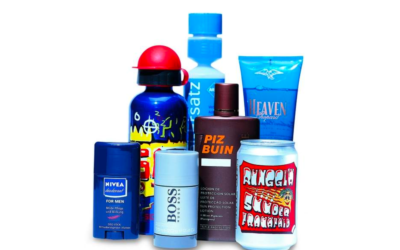Have you ever tried to write on glass or a slick surface with a marker? The ink came right off, didn’t it? That’s because glass is a smooth, non-porous material. Since the ink from the marker isn’t able to absorb into pores in the material and it has nothing to cling to, it comes right off. There are paint pens you can use to write on glass by laying on a stroke of wet paint that dries and clings to the surface, but even they’re not permanent. After enough washes or weathering, the paint starts wearing and chipping off.
Early Attempts to Make Ink Stick
Before some scientific and technological breakthroughs, the way we used to get ink to stick to glass when decorating was by using ceramic ink at high temperatures. The surface of the glass was softened in an oven, heating it to just below its melting point. The ceramic pigments were then fused to the surface of the glass and permanently bonded to the material.
Unfortunately, this type of inorganic ink was less than environmentally-friendly. The inks typically contained toxic heavy metals making them hazardous to humans. Now imagine those inks being used to put images on your drinkware? Obviously, that wouldn’t be healthy, which is why glasses printed in this way have been subjected to recalls in the past.
Enter UV Curable Ink
Advanced science and technology led to the creation of UV curable inks. When ultraviolet light is used, it creates a chemical reaction in organic, UV pigments that forms a bond between them and the glass. The bonds can be enhanced by pretreating the glass in different ways, and also by choosing the right monomers to mix with the ink. A monomer is a molecule that can bond with an identical or different molecule to form a compound. Essentially, when light is used, the monomer in the ink joins with the molecules on the surface of the glass creating a compound bonding the two together. The ink cures and the bond is solidified in 12 to 24 hours; an oven can speed up the process.
The Monomer Trade-Off
Your results depend on what monomer is mixed with the ink. Usually, a printer can’t have it all, so if you want an ink that has the best adhesion, meaning it’ll form the strongest bond to the glass, you’ll have to accept ink with less resistance (more likely to wear), and vice versa. While it would be optimal to have both high resistance and high adhesion, those qualities are on opposite ends of the spectrum, as you can see by the images below. Despite this challenge in choosing between more rigid or more flexible inks, you still have excellent digital options for printing depending on your exact surface.


Does Glass Have to Be Primed or Pre-treated?
Maybe. Pre-treatment is needed for the best durability when using screen printed inks. If using digital printing, a process called Pyrosil can make ink more durable. Pyrosil is a flame technology that removes impurities from the surface of the glass and applies a silica structure to the surfaces that looks like microscopic branches. If you were making pottery, you might “score” a piece of clay to make it stick to another piece of clay since it’s hard to stick two smooth surfaces together. Scratching, or scoring, the surfaces with tools to make them more rough gives each piece a way to bond. The branches Pyrosil applies to surfaces is like adding a scored surface to the glass to create greater surface tension, making ink better adhere to it.
If the glass will be used in extreme environments associated with high heat or humidity (like drinking glasses that will go in a dishwasher), then using an adhesion promoter, or primer, is best. It provides an invisible layer of material that mechanically bonds to the glass and provides a better surface to which the digital ink can adhere.
In addition to pre-treatments, Pyrosil, and the highest-quality UV curable inks, Marabu also provides a clear overprint varnish that can be digitally printed only over the imaged areas of glass. It protects printing longer than gross applications that coat the whole glass surface. If you’re interested in any of the products we’ve mentioned or would like more information, you can find a distribution partner HERE or contact us. You can receive more printing tips here.




